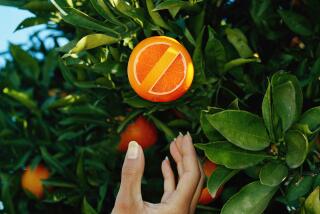Boysenberry, a California treasure

- Share via
To the uninitiated, the boysenberry may look like a big, blowzy, underripe blackberry, but it is in fact a noble fruit, as distinct from a common blackberry as a thoroughbred is from a mule.
Large, dark purple, juicy and intense, it derives its unique flavor from its complex ancestry: sweetness and floral aroma from its raspberry grandmother, and a winy, feral tang from three native blackberry species.
It’s a California classic, emblematic of the joys of growing up in the Southland before it succumbed completely to sprawl. And it’s all the more precious, despite its near extinction in this state, because it evokes why people moved here in the first place.
But Boysens can still be found if you know where to look, although their season is brief — late May to early July — and they are so delicate that as a fresh fruit they can be enjoyed at their best only from farmers markets, farm stands and home gardens.
The boysenberry was the fruit sensation of its era, rocketing from mysterious origins to be grown on some 2,400 acres in California by 1954. This gradually dwindled to 70 in 2008, and last year agricultural statisticians stopped counting, the ultimate indignity for the once-dominant variety.
One of the few remaining local growers, retired math professor Robert Poole, 72, came to love boysenberries in the early 1950s when his family grew a patch of them in Rialto for market, like hundreds of small farmers. This ended after his father died young of complications from a tonsillectomy, but Poole’s taste for Boysens lingered, and when he bought property in Redlands in 1977 he put in a modest planting for his family’s use.
He expanded production, but it was only when he started selling at farmers markets in the mid-1980s that he found a viable outlet for the perishable fruit. He and his family now cultivate 1 acre of berries, doing all the work themselves — planting, pruning, weaving the thorny canes onto wire trellises and harvesting. His wife, Patricia, makes boysenberry pies and jam, the most traditional uses for the fruit.
Most of the commercial Boysen crop has always gone into preserves, pies, syrups, juice, yogurt and ice cream. Ripe, fresh Boysens are so soft and thin-skinned that they leak juice and soon decay, so they must be sold within a day or two of harvest. Commercial shippers therefore have to compromise on maturity to get fresh Boysens to market with decent shelf life, but reddish, underripe fruits are quite tart for eating fresh.
“To be at their best, boysenberries need to be both really sweet and tart, that’s the combination,” says Gordon Mason, a software designer and self-proclaimed fruit connoisseur who tends his mother’s garden in West Los Angeles. “When they separate easily from the calyx, the white part underneath turns translucent, and the drupelets start to shrivel a little bit. That’s when they’re spot-on.”
The Boysen’s soft texture and rich, fruity flavor come from Rubus ursinus, a wild blackberry species improbably descended from a cross with a giant raspberry now found only on the island of Hawaii. Native to the Pacific Coast from Oregon to Southern California, it’s one of several American species of so-called dewberries, basically blackberries with a trailing habit (tending to sprawl close to the ground, rather than growing upright) that were domesticated starting in the late 19th century.
In 1881, Judge James Logan of Santa Cruz planted seeds from ursinus plants growing in his garden next to raspberries. He came up with the loganberry, a celebrated hybrid with large, conical, reddish-purple fruits. It was a leading variety for several decades, much prized for wine, juice and preserves.
The exact parentage of boysenberry is obscure, but scientists surmise, based on analyses of genes, plants and fruits, that it resulted from a cross of Logan with an Eastern dewberry. It may in fact have been one of the famous plant breeder Luther Burbank’s seedlings, which somehow made its way to John Lubben’s home in Alameda, Calif., and thence to his Napa County farm, where it was called lubbenberry.
In the early 1920s, Rudolph Boysen, who was farming Lubben’s property, was crossing blackberries and raspberries, and when he moved to Anaheim in 1923, he took with him some plants growing large, exquisitely flavored berries, which he claimed to have bred.
Boysen soon shifted his attention to growing oranges, but George Darrow of the U.S. Department of Agriculture, a great berry breeder, traveled from Maryland to see this novel fruit, marveled at it and contacted a small farmer, Walter Knott, at his Berry Place in Buena Park.
When Knott started growing the new variety in 1932, he found it surpassed the standard dewberry at the time, the milder, Louisiana-bred youngberry, in size, yield and profitability. He named it boysenberry and introduced it to the public in 1934, launching such a hullabaloo that by the next year this newspaper would trumpet it as the “California-developed king of the bush,” destined to trounce all rivals. From this start Knott’s Berry Farm, as the giant amusement park became known, took off.
So did boysenberry plantings, which expanded to 559 acres in 1940, with Los Angeles County in the lead. Acreage declined during the war because of the scarcity and high cost of labor, but boomed in the postwar decade, reaching a peak of several thousand acres in the late 1950s. The Boysen was then the preeminent bush berry grown in California, far exceeding raspberries and other blackberries.
Meanwhile, as development consumed farmland near Los Angeles, most production shifted to the areas around Modesto and Fresno, and focused on processing. Boysens are not ideally suited to the San Joaquin Valley, particularly the hottest, most arid southern reaches, where broiling days scald the berries and plants, and low humidity and warm nights diminish fruit size; but growers made a go of it for many years, using migrant farmworkers and students for harvest labor.
In the 1960s, the Boysen began a slow decline: Its trailing habit made it difficult and expensive to manage; the plant was susceptible in coastal areas to fungal disease; the soft, leaky berry offered poor shelf life; supermarket chains and food service preferred fruits with year-round availability; competition from imported frozen Boysens diminished profits. The Boysen was supplanted by more productive, better-adapted hybrid blackberries, Olallie for fresh market in California, Marion for processing in Oregon. When picked ripe, these and similar Western varieties can offer very good flavor, but they are different from Boysens.
Today, improved varieties of Eastern blackberries, grown in Mexico, the Southeast and California, dominate the fresh market. Oregon, which has a large berry processing industry, grows most of the nation’s remaining Boysens, some 600 acres, which are mechanically harvested at night when they are firmer and come off more readily.
Meanwhile, several breeders, including Chad Finn of the USDA in Corvallis, Ore., have pursued a dream of berries with the superb flavor of Boysen but firm enough to ship. Until recently, Finn’s new varieties were not readily available in California. But three years ago, the Willems family of Kingsburg, south of Fresno, planted 20 acres of a complex hybrid involving Boysen, Logan and Marion, officially named newberry, which they are marketing as “Ruby Boysen” to chains including Trader Joe’s, Costco and Albertsons.
Sweeter and lighter in color than Boysen, with a stronger skin, this variety has outstanding flavor. But it may never replace the original in the hearts of aficionados, who can only hope that if enough of them vote with their dollars, there may be life in the old berry yet.
More to Read
Eat your way across L.A.
Get our weekly Tasting Notes newsletter for reviews, news and more.
You may occasionally receive promotional content from the Los Angeles Times.










